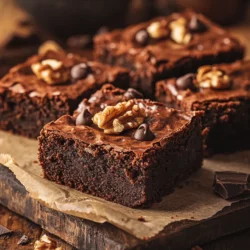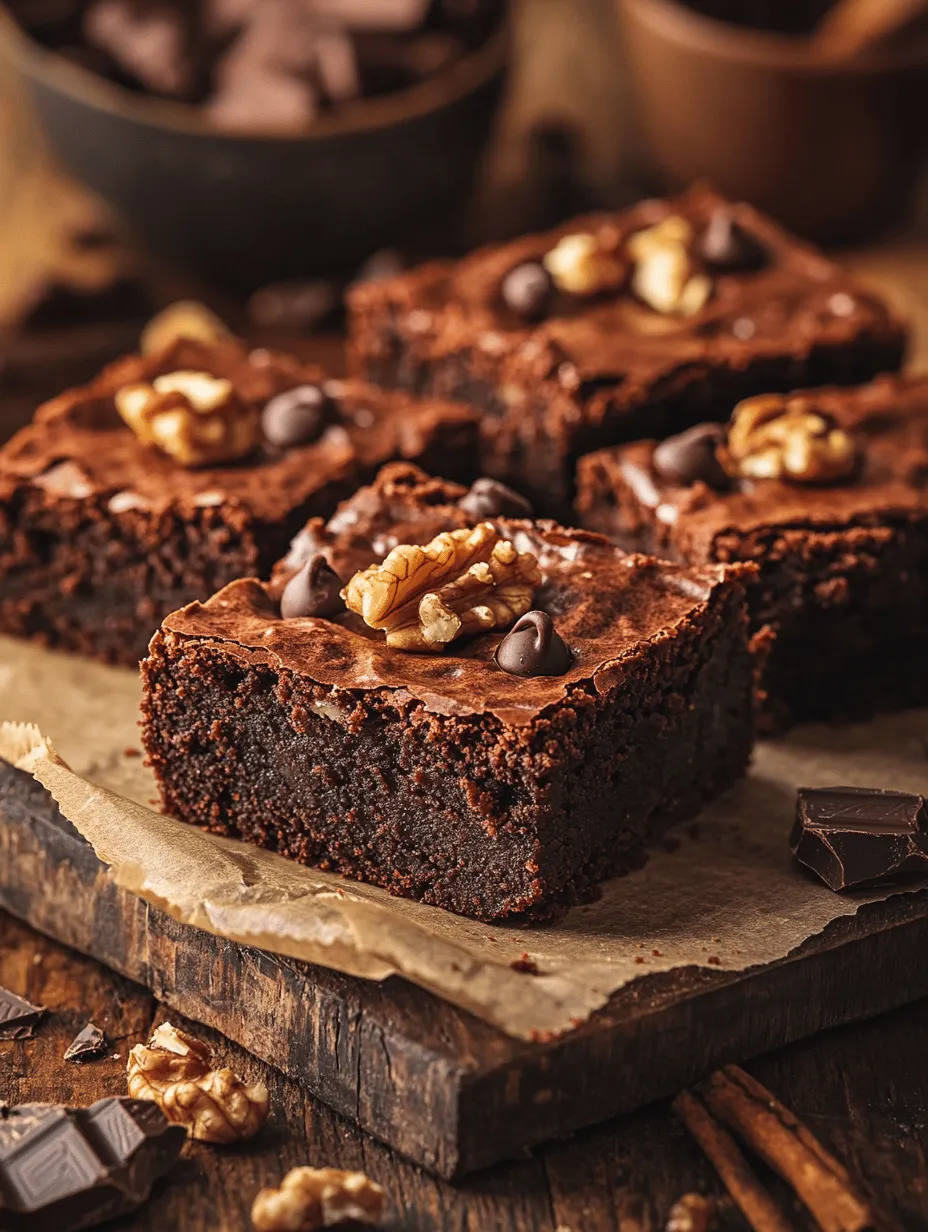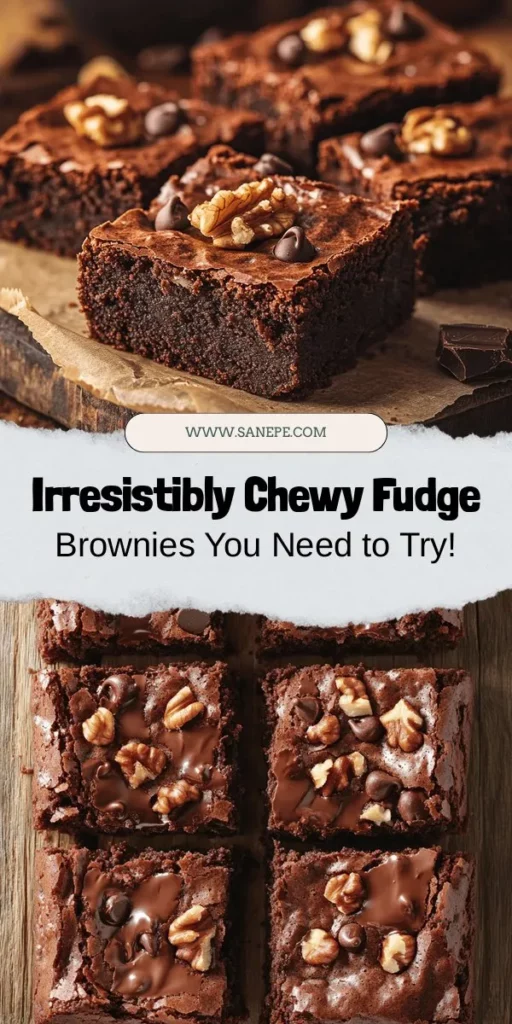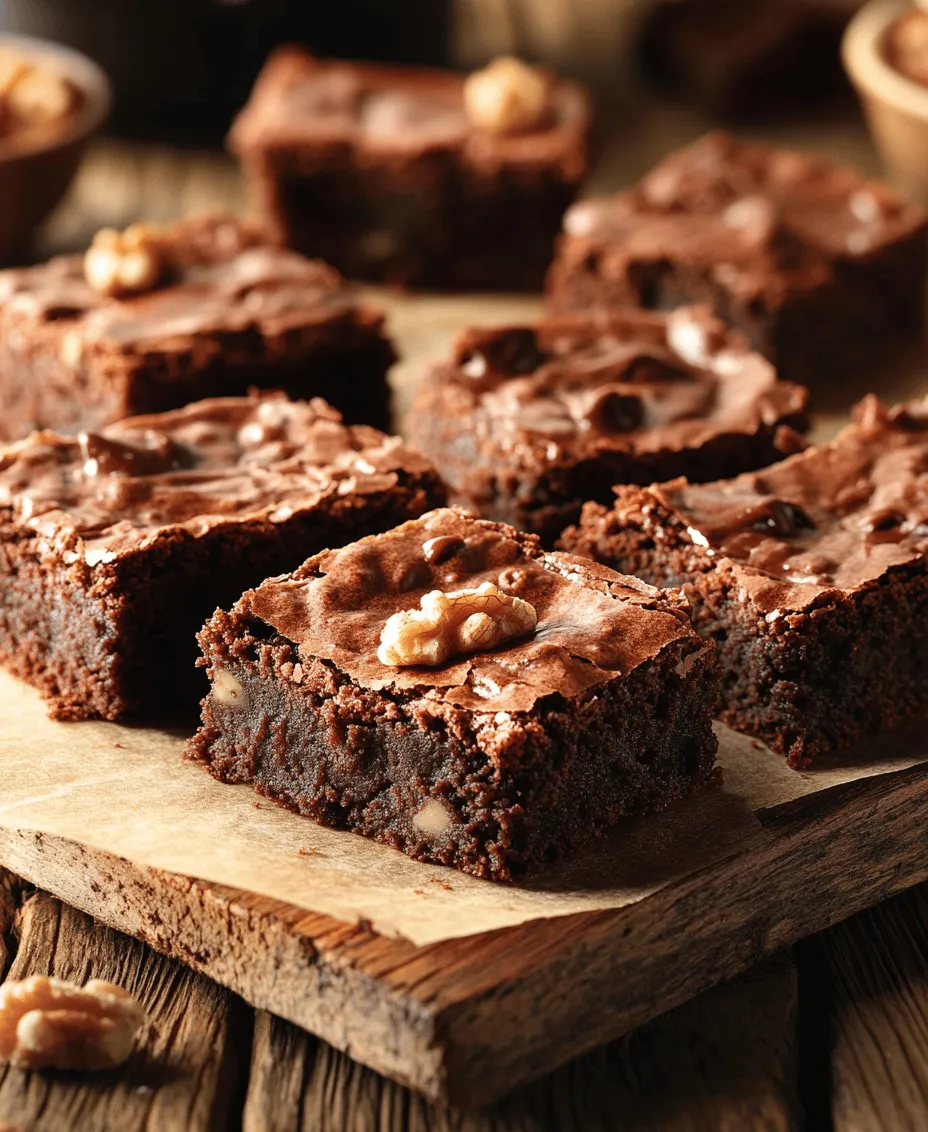Introduction
Brownies are more than just a dessert; they are a universally loved treat that evokes memories of childhood baking sessions, cozy gatherings, and indulgent moments. Their rich, chocolatey flavor paired with a satisfying texture makes brownies a staple in dessert menus and home kitchens alike. From the dense and fudgy to the light and cakey, there’s a brownie for every palate. However, when it comes to achieving that perfect chewy fudge brownie, the secret lies in the ingredients and the method used to prepare them.
Introducing our Chewy Fudge Brownies, a recipe that celebrates the deep, rich flavor of cocoa while delivering that irresistible chewy texture that keeps you coming back for more. This recipe is designed for chocolate lovers who crave a dessert that packs a punch of cocoa goodness with every bite. By focusing on quality ingredients and precise techniques, you can create brownies that are not only delicious but also memorable.
For the best results, it’s essential to use high-quality ingredients. Each component plays a crucial role in creating the perfect brownie, and understanding these ingredients will help you appreciate the craft of baking. Let’s dive into the specifics of what makes these brownies a true indulgence.
Understanding the Core Ingredients
Unsalted Butter: The Foundation of Chewiness
Butter is a key ingredient in brownies, providing the necessary fat that contributes to their rich flavor and chewy texture. Unsalted butter is preferred in baking, as it allows you to control the salt content of your recipe. When melted, butter adds moisture and a slight sheen, making the brownies tender yet dense. The fat in butter also helps in creating a pleasing mouthfeel, ensuring each bite is decadent.
Granulated and Brown Sugar: Sweetness and Moisture
The combination of granulated and brown sugar is essential for achieving the perfect balance of sweetness in your brownies. Granulated sugar helps to create a crisp top layer, while brown sugar, with its molasses content, adds moisture and a hint of caramel flavor. This duo not only sweetens the brownie but also contributes to the overall texture, keeping it soft and chewy.
Eggs: Structure and Richness
Eggs play a pivotal role in baking, especially in brownie recipes. They provide structure and stability, allowing the brownies to rise while maintaining their fudgy texture. The proteins in eggs coagulate during baking, helping to bind the ingredients together. Additionally, eggs add richness, contributing to the overall flavor and mouthfeel of the brownies.
Vanilla Extract: Enhancing Chocolate Flavor
Vanilla extract is often an overlooked ingredient, but it plays a significant role in enhancing the overall flavor profile of your brownies. It complements the chocolate, adding depth and complexity to the taste. A splash of high-quality vanilla extract elevates the chocolate flavor, making each bite even more delightful.
All-Purpose Flour: The Backbone of Brownies
All-purpose flour is the backbone of any brownie recipe, providing the necessary structure to hold everything together. It absorbs moisture from the butter and eggs, creating a cohesive batter. The amount of flour used is crucial; too much flour can lead to dry brownies, while too little may result in a gooey texture. Striking the right balance is essential for that perfect chewy consistency.
Unsweetened Cocoa Powder: The Star Ingredient
When it comes to brownie recipes, unsweetened cocoa powder is the star ingredient that delivers a deep, intense chocolate flavor. It adds richness and complexity, making the brownies taste indulgent without being overly sweet. The quality of cocoa powder can significantly impact the final product, so opting for a high-quality brand can take your brownies to the next level.
Baking Powder and Salt: Balancing Flavor and Texture
Baking powder is a leavening agent that helps the brownies rise slightly, giving them a tender crumb. Its role is subtle but essential, ensuring that the brownies are not overly dense. Salt, on the other hand, is a flavor enhancer. A pinch of salt in your brownie batter can elevate the sweetness and bring out the cocoa flavor, creating a well-rounded taste.
Semi-Sweet Chocolate Chips: Bursts of Chocolate Delight
No brownie is complete without chocolate chips. Semi-sweet chocolate chips add pockets of melted chocolate that create an indulgent experience with every bite. They contrast beautifully with the fudgy brownie base, adding another layer of texture and flavor. You can adjust the amount to suit your preference or even mix in dark chocolate chips for a richer taste.
Chopped Walnuts: Optional Texture and Flavor Enhancement
For those who enjoy a bit of crunch in their brownies, adding chopped walnuts is a fantastic option. These nuts provide a delightful contrast to the smooth, fudgy brownie and add an earthy flavor that complements the chocolate. If you’re not a fan of nuts, feel free to leave them out or substitute with another mix-in of your choice, such as peanut butter chips or coconut flakes.
Preparation Steps Explained
Now that we’ve covered the essential ingredients, let’s move on to the preparation process. Baking brownies is not just about mixing ingredients; it’s about understanding the techniques that will yield the best results. Here’s a step-by-step breakdown of how to prepare these chewy fudge brownies.
Melting Butter: Techniques for Perfect Melting
Begin by melting the unsalted butter. You have a couple of options: you can melt the butter in a microwave-safe bowl in short bursts of 20-30 seconds, stirring in between, or you can do it on the stovetop in a small saucepan over low heat. The key is to melt the butter gently, ensuring it doesn’t bubble or boil, as this can incorporate unwanted air into your batter. Once melted, let it cool slightly before mixing it with the sugars to avoid cooking the eggs in the next step.
Combining Sugars: Ensuring a Smooth Mixture
In a large mixing bowl, combine the melted butter with the granulated and brown sugars. Use a whisk or a spatula to mix them together until the mixture is smooth and glossy. This step is crucial, as it helps to dissolve the sugars and creates a base for your brownie batter. The goal is to achieve a creamy consistency that will contribute to the chewy texture of the finished brownies.
Incorporating Eggs: Tips for Preventing Curdling
Next, it’s time to add the eggs. Crack them into a separate bowl to check for any shell fragments, then add them to the sugar-butter mixture. It’s important to mix the eggs in thoroughly, but be careful not to overmix. Whisk just until the eggs are fully incorporated, which will help create a uniform batter without curdling. If you overmix, you risk incorporating too much air, which can lead to cakey brownies instead of the desired chewy texture.
As you can see, the preparation of these chewy fudge brownies is both straightforward and rewarding. By understanding the roles of each ingredient and following these initial steps carefully, you set yourself up for brownie success. In the following sections, we will delve into the remaining steps of the recipe, ensuring you achieve the perfect batch of brownies that are sure to impress.
Sifting Dry Ingredients: Importance of Aeration in Baking
Sifting dry ingredients is a crucial step in the brownie-making process that should never be overlooked. This technique serves multiple purposes, primarily aerating the flour and helping to eliminate any lumps. When flour is sifted, it becomes lighter and incorporates air, resulting in a more tender brownie. This is especially important when working with dense ingredients like cocoa powder, as it allows for a more consistent texture throughout the batter.
In addition to aerating, sifting also ensures that the leavening agents like baking powder and baking soda are evenly distributed in the mixture. This promotes even rising during baking, preventing any dense or gummy spots that can detract from your chewy fudge brownies. To sift effectively, use a fine-mesh sieve or a sifter, pouring the dry ingredients into it and shaking it gently over the mixing bowl. This simple action can significantly enhance the final product, making your brownies light and delicious.
Folding in Chips and Nuts: Technique for Even Distribution
Once your dry ingredients are sifted and your wet mixture is ready, it’s time to combine them. When incorporating chocolate chips and nuts into your brownie batter, the technique of folding is paramount. Folding is a gentle mixing method that helps retain the air you’ve incorporated into your batter, keeping it light and fluffy.
To fold in the chocolate chips and nuts, use a spatula or a wooden spoon. Start by adding a portion of the dry mixture to the wet ingredients and gently stir until just combined. Then, add half of your chips and nuts, folding them in with a few strokes. Repeat with the remaining dry ingredients, and finish by folding in the rest of the chips and nuts. This method ensures that every bite of your brownies is packed with rich chocolate and crunchy nuts without overmixing, which can lead to tough brownies.
Visual Cues to Look for at Each Stage, Ensuring Accuracy
As you embark on your brownie-making journey, paying attention to visual cues can help ensure you achieve the perfect texture and consistency. Here are some key indicators to look for at each stage:
1. Batter Consistency: When mixing your dry and wet ingredients, the batter should be thick yet pourable. It should fall from the spatula in ribbons but hold its shape without being runny.
2. Incorporation of Ingredients: After folding in your chocolate chips and nuts, the batter should be speckled with evenly distributed chunks, and you should not see any dry flour streaks.
3. Baking Stage: As your brownies bake, they will initially rise and puff slightly. Once baked, they will settle back down, forming a shiny crust on top. This glossy finish is a sign of properly melted chocolate that contributes to the chewy texture.
4. Testing for Doneness: Use a toothpick or skewer inserted into the center of the brownies. It should come out with a few moist crumbs but not wet batter. This indicates that your brownies are perfectly baked, retaining their fudgy center.
Baking Tips for Perfect Brownies
Ideal Oven Temperature and Why It Matters
The ideal temperature for baking brownies is typically set between 325°F and 350°F (163°C to 177°C). Baking at a lower temperature can result in a denser, fudgier brownie, while a higher temperature can lead to a cakey texture. It is essential to preheat your oven before placing the brownies in to ensure even baking from the start. Use an oven thermometer to double-check your oven’s accuracy, as an inconsistent temperature can drastically affect the outcome.
Understanding the Baking Time and How to Test for Doneness
Brownies typically take 20 to 30 minutes to bake, depending on the pan size and oven settings. It’s important to keep an eye on them as they approach the end of the baking time. Begin checking for doneness around the 20-minute mark. Remember, the edges will appear set while the center may look slightly undercooked; this is normal as brownies continue to cook while cooling.
When testing for doneness, insert a toothpick into the center of the brownie. If it comes out with a few moist crumbs, your brownies are done. If it comes out with wet batter, they need more time. Remember to avoid overbaking, as this will lead to dry brownies instead of the desired chewy texture.
Importance of Cooling Before Cutting: Achieving Clean Edges and Preventing Crumbles
Allow your brownies to cool in the pan for at least 10-15 minutes before attempting to cut them. This step is crucial for achieving clean edges and preventing crumbles. Cooling allows the brownies to firm up, making it easier to cut them into perfect squares. For even better results, consider transferring the brownies to a wire rack to cool completely. This allows air to circulate around the brownies, preventing condensation that can lead to a soggy bottom.
Variations and Customizations
Exploring Different Flavor Profiles
While the classic chewy fudge brownie is delicious on its own, experimenting with different flavors can elevate your baking experience. Consider adding a few drops of peppermint extract for a minty twist or incorporating espresso powder for a rich, coffee-infused flavor. Both variations enhance the chocolate and create a unique depth of flavor.
Suggestions for Alternative Mix-Ins
Get creative with mix-ins to personalize your brownies. Swap out traditional chocolate chips for white chocolate or butterscotch chips for a different taste. Dried fruits like cherries or cranberries can also add a pleasant tartness that complements the sweetness of the brownies. For a nutty crunch, try adding chopped pecans, walnuts, or even toasted coconut flakes for extra texture.
Gluten-Free Options: Substituting Flour with Gluten-Free Alternatives
For those with gluten sensitivities, adapting the brownie recipe to be gluten-free is straightforward. Substitute all-purpose flour with a gluten-free blend that includes xanthan gum, or use almond flour for a nutty flavor. Keep in mind that the texture may vary slightly, but with the right blend, you can still achieve that chewy, fudgy texture.
Serving Suggestions
How to Serve Brownies for Various Occasions
Brownies are versatile desserts that can be served for any occasion, from casual family gatherings to formal parties. For a simple dessert setup, cut brownies into squares and serve them on a platter. If you’re hosting a party, consider stacking them in a decorative tower for an impressive display. For a cozy movie night, offer brownies alongside popcorn and a choice of ice cream.
Pairing Ideas
Pairing brownies with complementary flavors can elevate the dessert experience. Serve warm brownies with a scoop of vanilla ice cream or a dollop of whipped cream. The contrast of warm, fudgy chocolate and cold, creamy ice cream is a match made in heaven. For a more indulgent treat, drizzle with caramel or chocolate sauce before serving.
Creative Presentation Ideas for Enhancing Visual Appeal
Presentation is key to making your brownies stand out. Consider dusting them with powdered sugar or cocoa powder for an elegant touch. Adding fresh berries or mint leaves can brighten the plate and add a pop of color. Use fun plates or tiered stands to create an inviting dessert table that draws guests in.
Nutritional Information
Breakdown of Calories and Macronutrients per Serving
Understanding the nutritional content of your brownies can help you enjoy them in moderation. On average, a standard serving of chewy fudge brownies contains approximately 200-250 calories, depending on the size and ingredients used. Each brownie typically has around 10-15 grams of fat, 25-35 grams of carbohydrates, and 2-4 grams of protein.
Discussion on Indulgence versus Moderation in Dessert Consumption
While brownies are undoubtedly a decadent treat, it’s essential to enjoy them mindfully. Indulging in a brownie every now and then can be part of a balanced diet. Opt for smaller portions and savor each bite, allowing yourself to appreciate the rich flavors. Remember, desserts are meant to be enjoyed, and moderation is key to maintaining a healthy relationship with food.
Conclusion
Baking chewy fudge brownies is a delightful experience that combines the joy of creating something delicious with the pleasure of sharing it with others. The process of mixing, baking, and finally slicing into those rich, chocolatey squares can be incredibly rewarding.
We encourage you to experiment with the basic brownie recipe, trying out different flavor profiles and mix-ins to make it your own. Whether you prefer classic, nutty, or gluten-free versions, the possibilities are endless.
Brownies hold a timeless appeal in the world of desserts, perfect for celebrations, gatherings, or simply a sweet treat at the end of the day. So gather your ingredients, preheat that oven, and unleash the cocoa power to create a batch of irresistible chewy fudge brownies that will surely delight everyone who gets to taste them.



